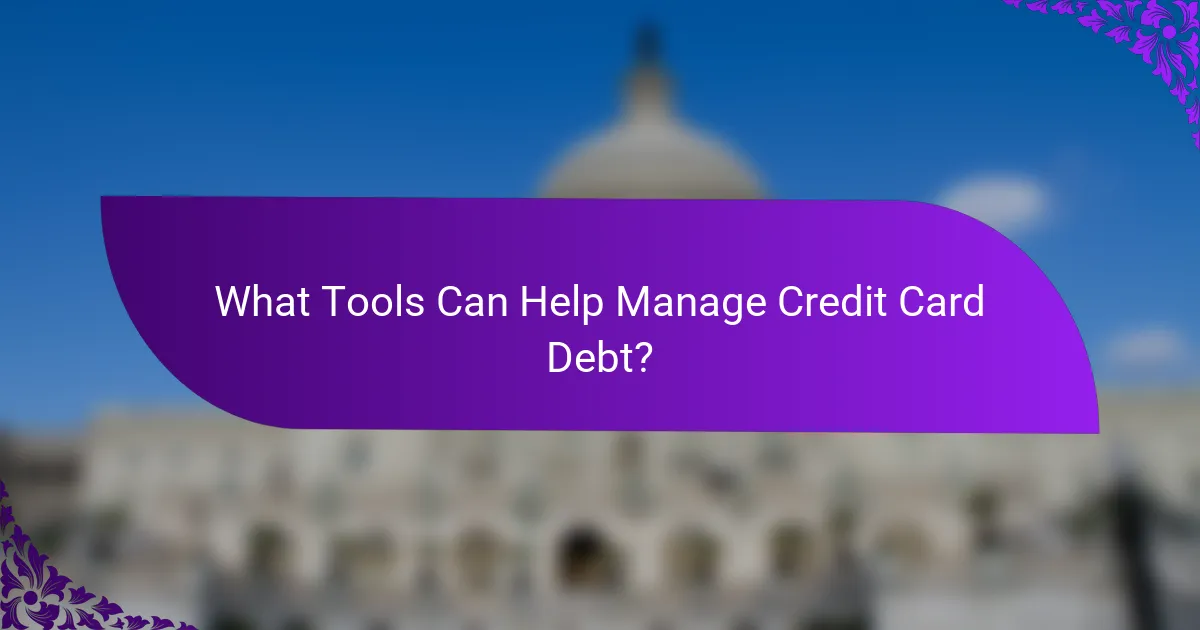Managing credit card debt is crucial for achieving financial stability and reducing stress. By employing effective techniques such as the Debt Snowball and Debt Avalanche methods, along with utilizing helpful tools for tracking expenses and monitoring credit scores, individuals can take control of their finances. The benefits of proper debt management extend beyond just repayment, leading to improved credit scores and enhanced overall financial health.

What Are the Best Techniques for Credit Card Debt Management?
Effective credit card debt management techniques can help individuals reduce their debt burden and improve financial stability. Key strategies include the Debt Snowball Method, Debt Avalanche Method, balance transfers, debt consolidation loans, and negotiating with creditors.
Debt Snowball Method
The Debt Snowball Method focuses on paying off the smallest debts first while making minimum payments on larger debts. This approach can boost motivation as individuals see debts eliminated quickly.
To implement this method, list all credit card debts from smallest to largest. Allocate any extra funds to the smallest debt until it is paid off, then move to the next smallest. This method can be particularly effective for those who need quick wins to stay motivated.
Debt Avalanche Method
The Debt Avalanche Method prioritizes debts with the highest interest rates, which can save money over time. This strategy requires discipline, as it may take longer to pay off smaller debts first.
To use this method, list debts by interest rate, paying the minimum on all but the highest interest debt. Direct any extra funds towards the highest rate debt until it is eliminated, then move to the next highest. This method is ideal for those focused on minimizing interest payments.
Balance Transfers
Balance transfers involve moving debt from one credit card to another, typically to take advantage of lower interest rates. Many credit cards offer promotional rates for balance transfers, which can significantly reduce interest costs.
When considering a balance transfer, look for cards with low or 0% introductory rates and be aware of any transfer fees. Ensure that you can pay off the transferred balance before the promotional period ends to avoid high interest rates afterward.
Debt Consolidation Loans
Debt consolidation loans combine multiple debts into a single loan with a potentially lower interest rate. This can simplify payments and reduce overall interest costs.
To pursue this option, research lenders offering personal loans or home equity loans. Compare interest rates and terms, and ensure that the new loan fits your budget. Be cautious of extending the repayment period, which could lead to paying more in interest over time.
Negotiating with Creditors
Negotiating with creditors can lead to reduced interest rates or payment plans that make debt more manageable. Many creditors are willing to work with borrowers facing financial difficulties.
To negotiate effectively, prepare by gathering information about your financial situation and be clear about what you can afford. Contact your creditors directly and propose a realistic solution, such as a lower interest rate or a temporary payment reduction. Document any agreements made for future reference.

What Tools Can Help Manage Credit Card Debt?
Several tools can effectively assist in managing credit card debt, helping you track expenses, monitor credit scores, and create repayment plans. Utilizing these resources can streamline your financial management and ultimately reduce your debt burden.
Mint for Budgeting
Mint is a popular budgeting tool that allows users to track their spending and set financial goals. By linking your bank accounts and credit cards, Mint categorizes transactions, providing a clear overview of your financial situation.
To effectively use Mint, regularly review your spending categories and adjust your budget as needed. Set alerts for bill due dates and spending limits to avoid overspending and late fees.
Credit Karma for Monitoring
Credit Karma offers free access to your credit score and credit report, helping you monitor your financial health. It provides insights into factors affecting your score and alerts you to any significant changes.
Utilizing Credit Karma can help you identify areas for improvement, such as reducing credit utilization or addressing late payments. Regularly check your score to stay informed and make strategic decisions regarding your credit card usage.
Debt Payoff Planner Apps
Debt payoff planner apps, such as Undebt.it or Debt Payoff Planner, help you create a personalized repayment strategy. These tools allow you to input your debts, interest rates, and monthly payments to visualize your progress.
Choose a method like the snowball or avalanche technique to prioritize your payments. These apps can help you stay motivated by showing how much interest you save over time and when you’ll be debt-free.
Personal Finance Software
Personal finance software, like Quicken or YNAB (You Need A Budget), provides comprehensive tools for managing your overall financial picture. These programs often include budgeting, expense tracking, and debt management features.
When selecting personal finance software, consider your specific needs and whether you prefer a one-time purchase or a subscription model. Many of these tools offer free trials, allowing you to test them before committing.

What Are the Benefits of Effective Credit Card Debt Management?
Effective credit card debt management can lead to significant financial advantages, including a better credit score, reduced stress, increased savings, and improved financial planning. By actively managing debt, individuals can enhance their overall financial health and stability.
Improved Credit Score
Managing credit card debt effectively can lead to a higher credit score, which is crucial for securing loans and favorable interest rates. Timely payments and maintaining low credit utilization ratios—ideally below 30%—are key factors in improving credit scores.
For example, if you have a credit limit of $10,000, keeping your balance under $3,000 can positively impact your credit score. Regularly checking your credit report for errors and disputing inaccuracies can further enhance your score.
Reduced Financial Stress
Effective debt management can significantly lower financial stress by providing a clearer understanding of one’s financial situation. Knowing that debts are being handled responsibly can bring peace of mind and reduce anxiety related to financial obligations.
Creating a budget that includes debt repayment can help track expenses and ensure that payments are made on time. This proactive approach can alleviate the worry of falling behind and facing penalties or increased interest rates.
Increased Savings
By managing credit card debt effectively, individuals can free up funds that would otherwise go towards high-interest payments. This allows for increased savings, which can be redirected towards emergency funds, retirement accounts, or other investments.
For instance, if you reduce your credit card interest payments by consolidating debt or negotiating lower rates, you can save hundreds of dollars annually. Allocating these savings into a high-yield savings account can further enhance financial growth.
Better Financial Planning
Effective credit card debt management facilitates better financial planning by providing a clearer picture of income and expenses. With a manageable debt load, individuals can set realistic financial goals and create actionable plans to achieve them.
Utilizing tools like budgeting apps or spreadsheets can help track spending and debt repayment progress. Regularly reviewing financial goals and adjusting plans as necessary ensures that individuals stay on track and make informed financial decisions.

How to Choose the Right Debt Management Strategy?
Selecting the right debt management strategy involves understanding your financial situation, spending habits, and the types of debt you hold. A tailored approach can help you effectively reduce your credit card debt and improve your financial health.
Assessing Your Financial Situation
Begin by taking a comprehensive look at your finances. List all sources of income, monthly expenses, and existing debts to get a clear picture of your financial health. This assessment will help you determine how much you can allocate towards debt repayment each month.
Consider using budgeting tools or apps to track your income and expenses. This can highlight areas where you can cut back, allowing you to redirect those funds towards paying down debt.
Understanding Your Spending Habits
Analyze your spending patterns to identify unnecessary expenses. Categorize your spending into essentials and non-essentials, and look for opportunities to reduce discretionary spending. This can free up more money for debt repayment.
Implementing a spending plan, such as the 50/30/20 rule, can help you allocate your income effectively. This rule suggests spending 50% on needs, 30% on wants, and 20% on savings and debt repayment.
Evaluating Debt Types and Interest Rates
Different types of debt come with varying interest rates and terms. Prioritize paying off high-interest credit card debt first, as it can accumulate quickly and cost you more in the long run. Consider consolidating debts with higher interest rates into a lower-rate option if possible.
Create a list of all your debts, including the type, balance, and interest rate. This will help you strategize your repayment plan, whether through the avalanche method (paying off highest interest first) or the snowball method (paying off smallest balances first for quick wins).

What Are the Common Mistakes in Credit Card Debt Management?
Common mistakes in credit card debt management include ignoring minimum payments and taking on more debt than one can handle. These errors can lead to increased interest charges, damaged credit scores, and prolonged financial stress.
Ignoring Minimum Payments
Ignoring minimum payments can result in late fees and increased interest rates, making debt harder to manage. Credit card companies typically require a minimum payment that is a small percentage of the total balance, often around 1-3%. Failing to meet this obligation can also negatively impact your credit score.
To avoid this mistake, set up automatic payments for at least the minimum amount due. This ensures you won’t miss a payment and incur additional charges. Additionally, consider paying more than the minimum whenever possible to reduce your overall debt faster.
Taking on More Debt
Taking on more debt while struggling with existing credit card balances can create a cycle of financial distress. Many individuals mistakenly believe that opening new credit accounts will help manage their current debt, but this often leads to higher overall debt levels and more complicated repayment plans.
To prevent this, evaluate your current financial situation before applying for new credit. Focus on paying down existing debt rather than accumulating more. If you find yourself needing additional funds, consider alternatives like personal loans with lower interest rates or seeking financial counseling.
